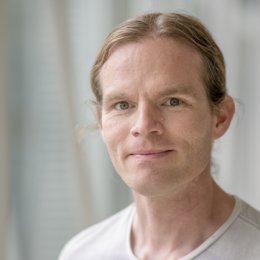Ivo Vellekoop is looking through opaque materials
It sounds impossible: making a sharp picture through an opaque material. Yet this is exactly what Ivo Vellekoop is working on: “In non-transparent materials, like white paint or our skin, microscopic particles in the material cause light to scatter. It gets diffused and no longer produces a sharp image,” he explains. The solution? Wavefront shaping. In 2007, Vellekoop and his supervisor Allard Mosk stood at the cradle of what has now grown into a completely new field of photonics.
“We were the first to focus light through an opaque material, something that many researchers at the time saw as fundamentally impossible,” he says. “With wavefront shaping, the phase and shape of a light wave are manipulated in such a way that constructive interference occurs in one specific spot, causing the light intensity to rise sharply. That way you can create a focus behind or even inside a non-transparent material.”
Wavefront shaping microscopy
Wavefront shaping has really taken off worldwide since Vellekoop’s promotion in 2008. “Although our research is fundamental in nature, we realized early on that wavefront shaping has promising applications,” he says. “You can potentially make a microscope with it that can see through anything. As long as you can produce the right wavefront shape for that specific piece of material.”
And that is not so straightforward: for every material, and moreover for every point inside that material, ‘the right wavefront shape’ is different and must be calculated and set separately, which is far from trivial. Yet, with increasingly smarter algorithms and models, it starts to become possible to use wavefront shaping for relevant measurements, such as for biomedical imaging. “There is an enormous expansion going on in the field. First it was purely fundamental physics, now we are dealing with advanced mathematics, machine learning, high performance computing and 3D modeling on the one hand, and biology and nonlinear microscopy on the other. This makes the field very interesting and dynamic.”
BioImaging Centre
Vellekoop is now also leading the first wavefront shaping microscopy facility in the BioImaging Centre of the University of Twente. “We offer a unique combination of equipment and technical support, which is also available to third parties, such as local startups,” he says. “Not only do we offer excellent commercial microscopes, but we also offer the possibility to experiment and make custom adjustments, for example for investigating Organ-on-Chip systems.”
Research and education
“As a professor in the current system, you don’t really have time to do research yourself.” says Vellekoop. “But at the same time, the concepts we are working on are so abstract and new that I must help to think them through. In fact, finding new solutions for ‘impossible’ problems is one of the best things about this job. My future dream? A microscope that really sees through everything at the push of a button.”
Vellekoop teaches the course Biomedical Optics and supervises students doing their graduation assignments. The professor emphasizes the need to have a feeling for what you are researching. “I think mathematics is very important. Some students find that complicated, but it is necessary for our work to understand what we see in the experiments,” he says. “In addition, I try to train that ‘feeling’ by always making the link between the abstract formulas and reality: what does a formula mean in practice?"
About Ivo Vellekoop
Ivo Vellekoop studied Electrical Engineering at the University of Twente from 1996 to 2003 and started studying fundamental (quantum) optics research during an internship. The fundamental nature of research in optics strongly appealed to him, and in 2003 he opted for a graduation assignment at the newly established chair of Complex Photonic Systems (COPS) of the Faculty of Applied Sciences. He obtained his doctorate at the same chair, where he and Allard Mosk were at the forefront of the new field of wavefront shaping. He held postdoc positions at the University of Zurich and at Caltech in California and has been back in Twente since 2012, at the chair of Biomedical Photonic Imaging.
Press Photos
These Press Photos can be used with no copyright restrictions.


